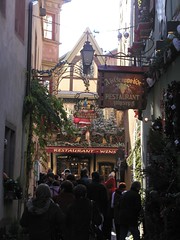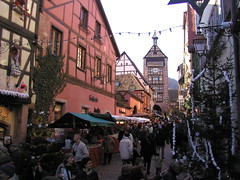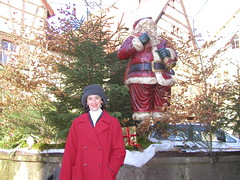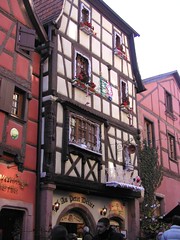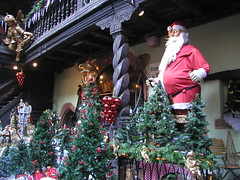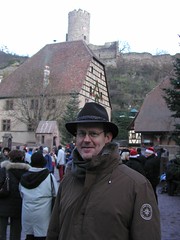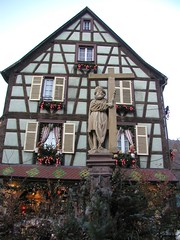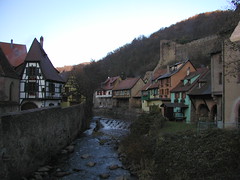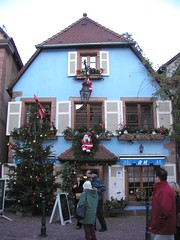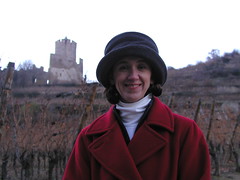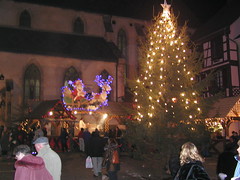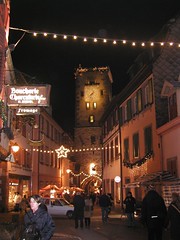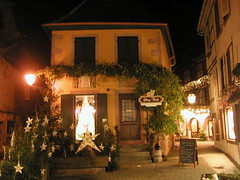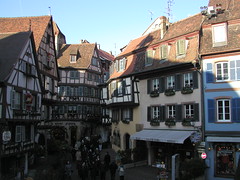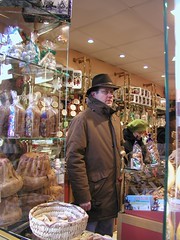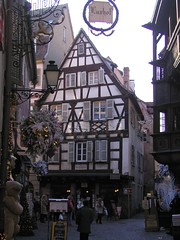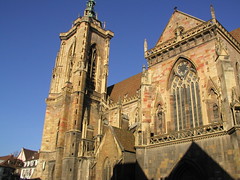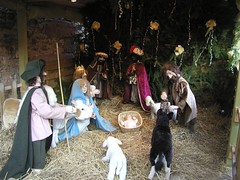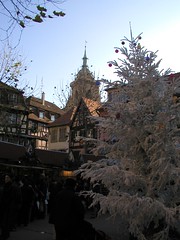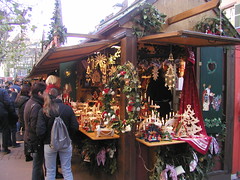Monday, December 26, 2005
The second day of Christmas
Today’s target run: 44 minutes
Today’s completed run: TBD
December 26th, the "Second Day of Christmas" (der zweite Weihnachtstag) also known as St. Stephen’s Day, has much the same function as the day before, being another public holiday and a day of family reunions or outings. People go to the homes of friends and family, partake in more eating, and generally have a relaxing time.
I can get on board with that.
No, second day of Christmas for us...we are headed to Istanbul through New Year's Day. Will be in touch....
Sunday, December 25, 2005
Frohe Weihnachten
Today’s run: rest
From the Budman and Hachie Gal:
May you have a blessed Christmas spent with family and friends, and the richest blessings in 2006! Or as they say in Germany,
Frohe Weihnachten und glückliches neues Jahr
Saturday, December 24, 2005
Christmas Eve
Today’s target run: 1 hour 28 minutes
Today’s completed run: 1 hour 28 minutes
Today is Christmas Eve. We are now kicking the holidays into high gear. Just as a sidenote, we’ve noticed some similarities as well as some differences in the day between Germany and the US.
Similarity: Yes, the grocery stores are open until about 2 pm, and they are packed.
Difference: While families gather together on Christmas Eve, this is the night of the big family meal in Germany, rather than on Christmas Day as we typically do in the US.
Similarity: Favorite family foods are in order at the family meal.
Difference: Many Germans serve fish (i.e. carp) or other fowl, whereas the turkey is the most common main dish entrée in the US…at least Southern US. (We did have some challenges finding pie crusts this year, but we hit pay dirt on chicken broth and cornmeal).
Similarity: In addition to the family dinner, there is also the unwrapping of gifts.
Difference: In Germany, gifts are usually opened on Christmas Eve, although in our families’ homes, we often opened gifts on Christmas Eve. Still, is iq quite common to open gifts on Christmas Day in the US.
Similarity: Many families conclude the evening by attending a midnight Christmas Mass. In the US, we often attend a Christmas Eve service.
Well, Budman and I had planned to cook up the big Christmas meal on Christmas Day for a party of two. We’d prepared the menu with the favorite foods (turkey, dressing, cranberry salad, swwet potatos, green bean/corn casserole, chess pie), as well as found all the ingredients at the local supermarket. Then, we received a late invite for Christmas Day lunch from some friends in southern Germany that quickly put all of that on hold. So we’re headed there tomorrow for a dinner with 14 others....
Never fear, as the food did not go to waste. We simply prepared the meal for Christmas Eve, sans Tom the Turkey (we’ll save him for a later date). And yes, there was much gift opening following dinner, as Deutsche Post made major deliveries today.
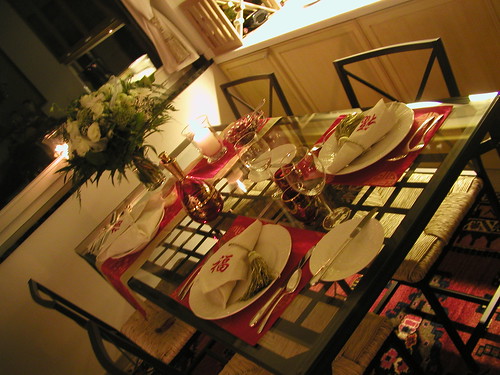
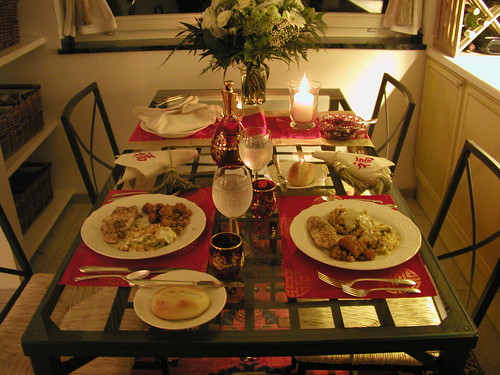
O Tannenbaum
The Christmas tree tradition can be traced to Northern Europe, but theories vary on what first inspired people to brighten the dead of winter by bringing nature into their homes. In the Middle Ages, some historians believe, Germans and Scandinavians began placing evergreen trees in their houses or outside their doors in winter as a sign of hope for the coming of spring. By another account, the English missionary Boniface, who came to Germany in the 8th century, introduced the practice of decorating a fir tree in honor of the Christ child to replace the pagan ritual of worshipping at an oak.
The first recorded appearance of a Christmas tree - Tannenbaum - was recorded in 1605 in Strasbourg, and the record said that "...people set up Christmas trees in their rooms...". The decorations hung on a tree of that time were "roses cut of many-colored paper, apples, wafers, gilt, sugar". People used different festive ornaments, nuts, candies, and candles to decorate the tree.
It is a widely held belief that Martin Luther, the sixteenth-century Protestant reformer, first added lighted candles to a tree. Walking toward his home one winter evening, composing a sermon, he was awed by the brilliance of stars twinkling among the evergreens. To recapture the scene for his family, he erected a tree in the main room and wired its branches with lighted candles.
The practice of putting up Christmas trees spread from Germany to North America with German immigrants settling in Pennsylvania and Ohio. German settlers in Pennsylvania began to decorate community trees and take trees into their homes in the 1700s. When a London newspaper published an image of Queen Victoria and her husband, Germany’s Prince Albert, and their family gathered around a Christmas tree in 1846, the custom suddenly became fashionable in both England and America.
Interestingly, many of the trees in Germany are not put up and decorated until Christmas Eve night when the family gathers together for the family meal and the opening of gifts. I saw many Christmas trees being delivered on 12/23 in the neighborhood. Budman and I decided, however, that we needed more “quality time” with our tree than that, having now enjoyed it for over 3 weeks…complete with only German ornaments.
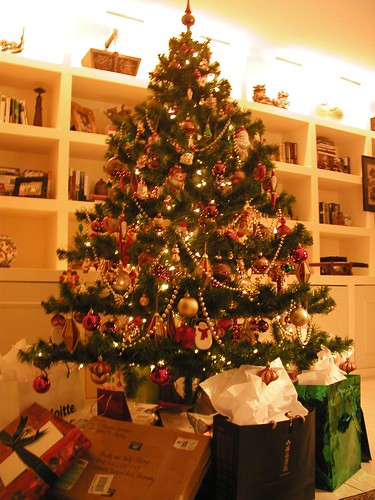
Friday, December 23, 2005
Office Christmas Party
Today’s target run: 33 minutes
Today’s completed run: 33 minutes
The Christmas holidays have definitively arrived…email traffic has slowed to a trickle, conference calls have all but diminished to a few persistent and hardy souls, and the out of office greetings of my colleagues from around the globe pepper my inbox.
Still, I am here through Friday night…when the Christmas break officially commences for me.
No company Christmas party or departmental lunch as occurred for me yet…and won’t unless I take matters into my own hands (one of the downsides of working remotely from your apartment).
So this morning, my two office mates and myself had a little Christmas gathering at the home office…consisted of some recently acquired Christmas cake and hot chocolate for me, and cat kibble and water for the office mates. Of course, the other team members do have a tough time focusing on their work and even getting too excited about the office Christmas party. They much prefer to sleep or look out the windows.
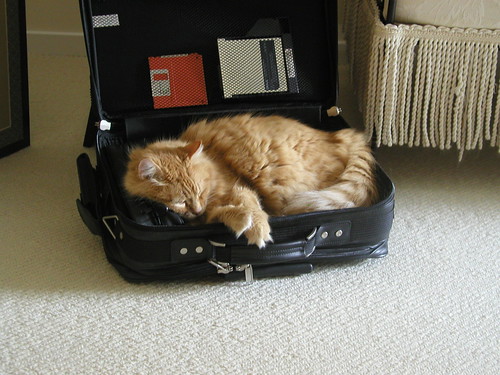
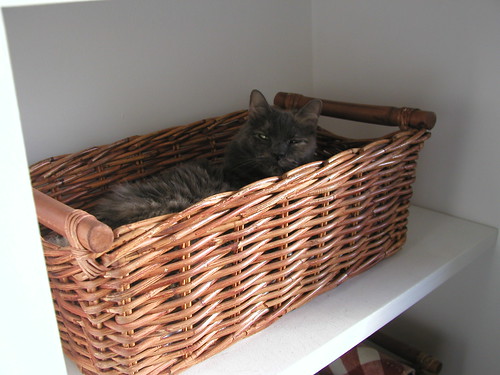
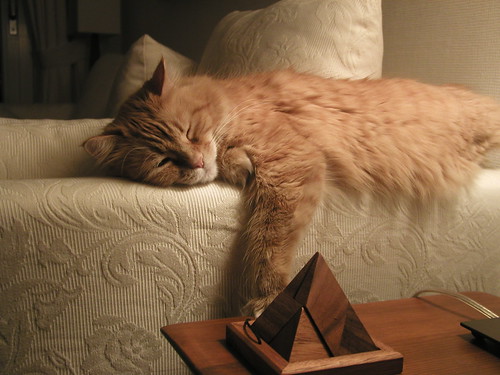

The employees of the Düsseldorf home office wish you all a very Merry Christmas and a Happy New Year.
Thursday, December 22, 2005
The evolution of Santa Claus
Today’s target run: 44 minutes
Today’s completed run : 44 minutes
Well, there are only a few more days to read about (or suffer through as the case may be) German Christmas traditions on the Hachie Gal’s blog. I must confess that I did not know that the world really has Germany to thank for the likeness of Santa that we hold dear to this day.
Essentially, it was Thomas Nast, a young German artist, who created the Christmas illustration which has shaped Americans’ view of Santa Claus that we hold to this day. In December 1862, Nast produced his first Santa drawings for Harper's magazine; however, the figure Nast drew was radically different from the way Santa had been thought of by the public. Up until this time, Santa was often portrayed as short and lean, with a sharp clean-shaven face and looking more like an evil demon than a benevolent gift-giver.
Nast felt that Santa was someone who should be beloved by children - not feared. So, he created the jolly old man of his imagination. He drew a sturdy Santa, wearing a wreath of holly, and smoking a long clay pipe. The Santa envisioned by Nast was almost always smiling, surrounded by a whole herd of reindeer pulling his sleigh. Before that, just one reindeer had usually been shown.
In 1866, Nast produced 20 Christmas scenes for Harper's, giving Santa some of the attributes that have been associated with him since, including:
* the tradition of hanging stockings by the fireplace for Santa to leave gifts in
* a record book with the names of good and bad children
* a telescope for checking up on the behavior of the children (I must confess, I have never heard of this one – have you?)
* a workshop where Santa and his elves make toys
The drawings were in black-and-white, but when Nast was asked to reproduce them for a later book to be produced in color, he made Santa's suit bright red. From this day forward, Santa Claus has always worn a red suit.
Now, if you’ve read previous posts, you’ll know that in Germany, Christmas gifts are often given by the Christkind or by St, Nikolaus (a forerunner to the evolved Santa Claus.) I get it though…no matter what country you live in, the gift thing figures predominantly…and that I like.
Wednesday, December 21, 2005
St. Thomas Day
Today’s target: 45 minutes cross-train
Today’s completed: 45 minutes cross-train
The Day of St. Thomas, celebrated on December 21, is also the day of the winter solstice, the year's longest night and shortest day. In Catholic Germany, St. Thomas is remembered on this day because he was the last one of the apostles to become convinced of Jesus' resurrection -- he was the one who for the longest time remained in the "night of unbelief and doubt." These are some of the traditions practiced on this day:
* Thomasfaulpelz or Domesel (lazybone or donkey of St. Thomas day) were names given to the last person to get out of bed and for the last student to appear in class on that particular morning in Westphalia (an area within Germany, and the area where Buddy and I currently live).
* The Rittburgische Hochzeit (Rittberg wedding), also a Westphalian custom, was an opulent meal served in the belief that if you ate well on St. Thomas day, you could expect to do so all of the next year.
* The Segensfrüchte (blessed fruit) represents basically the same idea. In southern Germany, it is hoped that when a bowl of fruit, vegetables, or nuts is placed on the table, a lack of them in the year to come will be prevented. Exchanging gifts of apples and nuts extended this wish to neighbors and friends.
* Blutiger Damerl (Bavarian dialect for bloody Thomas) and Schweinethomas (St. Thomas pig) may seem odd terms in connection with a saint. They refer to the tradition that demanded that on Bavarian farms as well as throughout other parts of Germany, the whole family and the farmhands sat down to an opulent meal of roasted pork on Christmas day. The pig especially raised for this occasion was called the "Weihnachter" (Christmas pig). It was usually slaughtered on this day to have the meat and sausages ready by Christmas.
Trying to steal a farmer's "Weihnachter," either alive or when it was butchered, worked about the same way as stealing the Maypole, only stealth and cunning were allowed, not bodily force. Very cautious owners slept in the piggery, so that they could better guard their "Weihnachter."
Tuesday, December 20, 2005
We’ve suffered a little setback
Paris Marathon Training: Week 3 of 18
Today’s target run: 44 minutes
Today’s completed run: 44 minutes
That’s what you get for bragging about a pending solution that has been your nemesis for 8 months. Yes, the satellite technicians (currently termed “sherpas”, as they are supposed to be guiding us as we scale this mountain we call “satellite TV in Germany”) have been to the apartment. Last weekend. They’ve surveyed the options, and supposedly the estimates for the hardware, installation, related equipment, and satellite programming packages are in the mail…email, that is. It’s Wednesday night and we’ve not yet seen a thing. Not a good sign.
Second issue: we were told by satellite sherpa #1 that he‘d been to this apartment building before. Essentially, once the huge German trees that front our street are full of leaves, you can’t get satellite reception. So, I can watch satellite TV for 6 out of 12 months. Fantastic. (No mention of this issue was raised by satellite sherpa #2 – should I feel encouraged or more worried?)
Third issue: the satellite programming company, Sky Broadcasting, is technically illegal in Germany. They do not have the right to broadcast, but everyone bypasses that and still buys the programming cards out of the UK. Why is this not a comforting thought?
Shame on me for bragging that I could possibly see the end of the TV wasteland I call German cable. I know better than to count my eggs before they’re hatched. Still, I was so hoping that Santa was going to install satellite for Christmas.
Best of luck "down under"
Safe travels to Melbourne, and the happiest of holidays! We look forward to hearing about your new experiences once you’re settled.
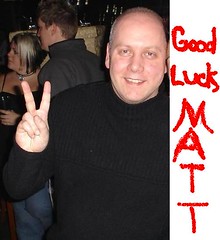
Monday, December 19, 2005
Köln Dom
Today’s target run: 33 minutes
Today’s completed run: 33 minutes
There is more to see in Köln than just Christmas markets, so a repeat visit is definitely in order. Although the primary purpose for this trip was the markets, we did see the magnificent Köln Dom as well as a few other buildings.
First, a little historical background. Originally founded by the Romans as Colonia Agrippina, Köln is one of the oldest towns in Germany. The Franks ruled the town from the end of the 5th century and Charlemagne raised its status to that of an archbishopric during his reign.
Secondly, in addition to THE Gothic cathedral, the Köln Dom, the city boasts of 12 Romanesque churches that are equally as interesting to visit or so we’ve been told. Like I said, a tour for a future visit.
Upon arrival in Köln, our first stop was actually the Köln Dom as it was literally right next to the main train station. And it is truly an impressive church. The foundation was laid in 1248 and building occurred on the church up through 1520. Another round of building occurred in 1842-1880 based on rediscovered original Gothic designs. It essentially required 600 years to complete the cathedral.


The cathedral’s interior, including the presbytery and chapels, retain a large number of Gothic stained glass windows, mainly from the 14th century. There was stained glass everywhere. So much so, that one became numbed by it all.
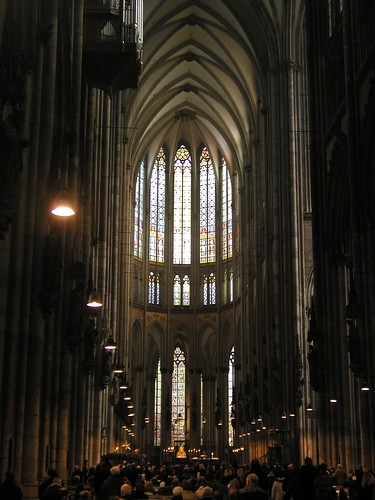

Interesting sidenote: A church service was in progress upon our arrival, and we entered the church (yes, they let us in, which I was quite surprised by) to the sounds of a boys' choir singing Ave Maria. Doesn't get much better than that...
Lots of beautiful artwork including a fine carving of the Milan Madonna and Child dating back to 1290,
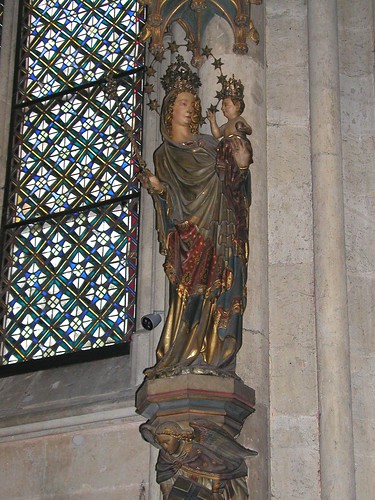
and the Shrine of the Three Kings, a huge reliquary/shrine made in 1181-1220 to hold the relics of the three kings, the patrons of Köln. These relics were brought to Köln in 1164 by Emperor Friedrich I Barabarossa. Yes, it is made entirely of gold.
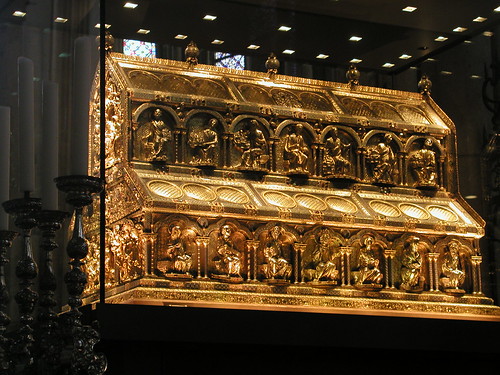
We also toured the cathedral's treasury (wow!) but no photos were allowed.
Cologne Christmas Market
Cologne has six Christmas markets, one of which is situated next to the city's gothic cathedral, the Cologne Dom. The cathedral's towers, reaching some 150 meters (490-feet) into the winter sky, made the very large Christmas tree in the middle of the setting appear quite small.
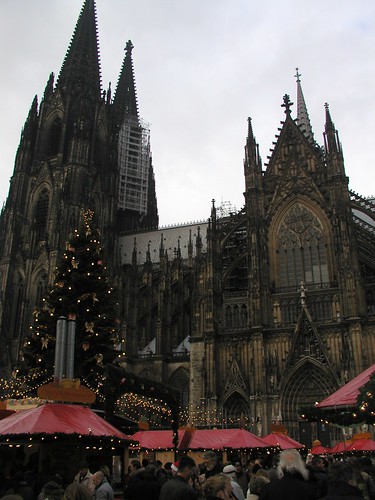


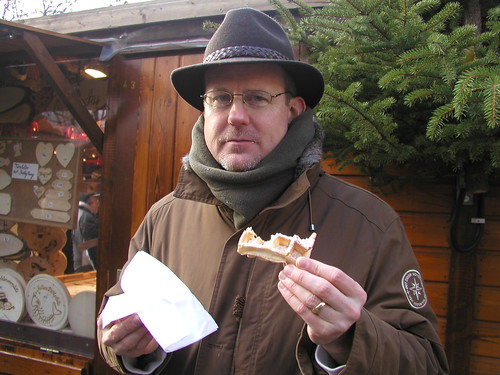
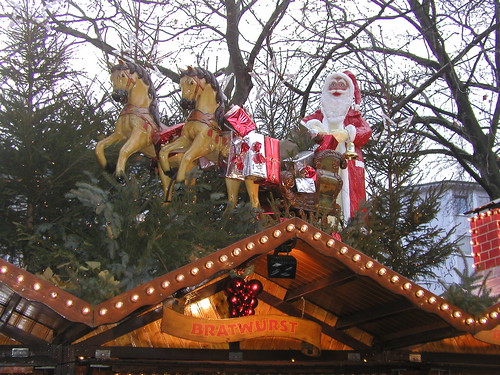
Supposedly, in the four weeks of December during which the markets are open, around 2 million people come to Cologne to enjoy the markets. I’d believe it as the cold weather and weekend snow did not keep the crowds at home yesterday.
In addition to the other four markets located at the Cologne Dom, the Rathaus, Altstadt, and Neumarkt, there was also a floating Christmas market,
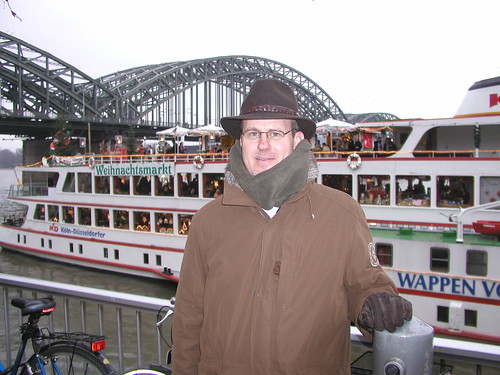
and a medieval Christmas market. Being from the Hachie, and experiencing all things related to “Scarbourough Fair”, we’d felt like we “see that and done that before”. You probably get the jest: salespeople wear wool clothes and wooden shoes and pursue medieval chores like blacksmithing. The smell of burning wood wafts through the air, and candles illuminate the setting. It was one of the more happening areas yesterday, but by the time we found it, and hassled with the crowds, we were ready to call it a day.
We perused the city for about 6 hours, ate and drank our usual Christmas market food and beverage items, and as usual, contributed a little to the local economy. The only down side to Cologne’s Christmas markets is that everywhere you turned, there was street work, building renovation, and city infrastructure projects going on. Sorta took away from the festive Christmas market atmosphere, but what is a city gonna do? Maybe this time next year, that will all be completed.
Sunday, December 18, 2005
Snow, snow, snow
Today's plan: 45 minutes cross-train
Today's actual: 45 minutes cross-train
Living in Texas, we rarely have white Christmases, let alone even get close. This weekend, we enjoyed a little snow, even though it was technically about a week early for a white Christmas. Still, it put us in a festive holiday spirit. Glad I got my run in before the snowfall began, though.
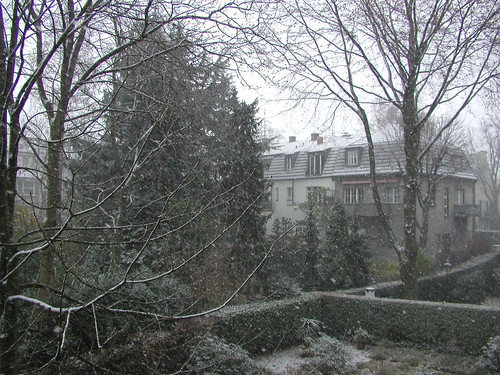
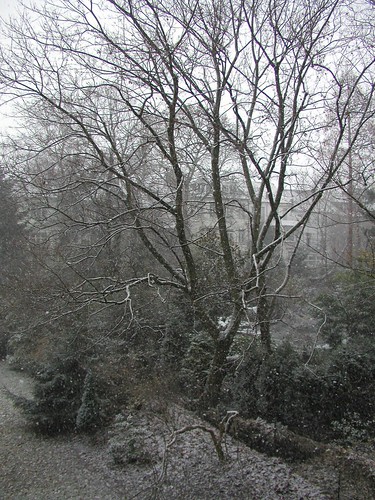
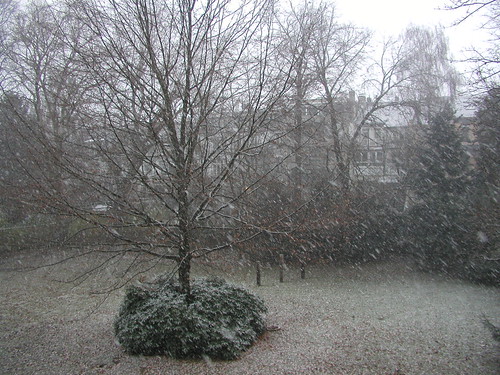
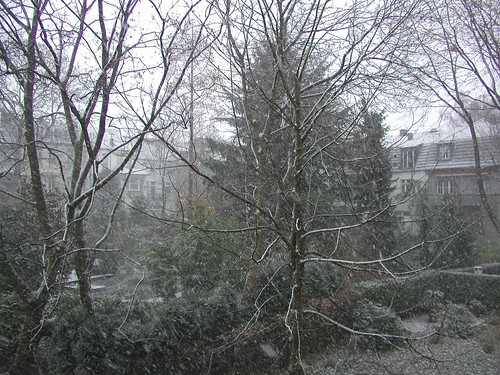
Saturday, December 17, 2005
What in the heck is Sudoku?
Today’s target run: 1 hour, 17 minutes
Today’s completed run: 1 hour, 17 minutes
I always thought that I was an “early adopter” (marketing lingo for the phase in which a person adopts a new concept, idea, product, etc. – I apparently do remember something from Baylor Marketing 101).
Still, I was not aware of what Sudoku was, let alone it even existed. I was totally clueless. More to the point, should I care? Should you care? If you are puzzle-working aficionado…oh yea, you care.
Thanks to the “Confused Swiss” (his nickname, not mine), I’ve been turned on to the latest puzzle craze in Europe. Check it out some sample puzzles of Suduko on the web if you are so inclined.
Warning: the Surgeon General has determined that Suduko puzzles can be hazardous to your health; they are addictive.
Friday, December 16, 2005
EEE-ther, EYE-ther
Today’s target run: 33 minutes
Today’s completed run: 33 minutes
There is no middle of the road. You are either in one camp or the other. It is either black or white (or in this case B&W or in technicolor). You say eee-ther and I say eye-ther. ToMAYto, toMAHto, poTAYto, poTAHto….
So, the issue of which I discuss is an annual debate held at this time of year among movie buffs that will probably never be settled. What is the quintessential Christmas movie?
Please, no Chevy Chase Christmas Vacation entries. If that is your choice, sadly, this blog is not for you (but you are always welcome to stop by).
And no, as much as I like to watch It’s A Wonderful Life 30 ga-zillion times each year, that is not THE ultimate Christmas movie either. Nor Miracle on 34th Street (either versions), Going My Way, The Bells of St. Mary’s, The Bishop’s Wife, or all the other host of wonderful holiday classics.
It is really only a two-horse race in my mind - and this is where is comes down to a clear choice for those fans of the Bing. It’s either Holiday Inn or White Christmas. Now, it gets sticky.
Both have their merits: Positives for Holiday Inn: Holiday Inn was the first film to feature the song White Christmas (not White Christmas, the movie) so kudos for that. It also combines the voice of Crosby, and the feet of Astaire, a truly winning combo. In 1942, the year the film was released, it was the highest grossing film of the year. It features all the great songs of Irving Berlin - every single song is great. And finally, you can’t beat the sentiment: living in a place you love, with the people you love, doing the work you love to do.
Now, I am clearly partial to Holiday Inn. That is my clear choice for the best holiday film, hands down. So, it is hard for me to bring up any negatives. Some would say that the fact that the film is in B&W is a negative, but to me that is not a detraction in the least. And please, let's not even discuss the issue of colorization.
Moving on to White Christmas: Again, features the song White Christmas, but the other songs are a bit dopey. They just do not hold up well, although Sisters and Snow, Snow, Snow are a couple that do. A dual-duo act this time in Crosby and Danny Kay, and Rosemary Clooney and Vera Ellen. Actually Rosemary is the better lead female of the two films. It’s in color. However, there are the serious drawbacks: mainly an obnoxious Danny Kay, sets that look just like the sets in Holiday Inn, and a story line that is a repeat of the first film in many ways. It just doesn’t cut it for me. Why settle for a repeat when you can enjoy the original?
I know readers of the blog will probably disagree and may even have their own recommendations for THE best Christmas movie. Whatever your choice, whichever side of the fence you fall on, pull out your favorite flick, curl up with good movie munchies, and enjoy!
We are moving on up the mountain to Base Camp 2
The initial problem, as you may remember, was that our initial request to the landlord to install a satellite on the outside of our building was denied, squashed, kabashed, vetoed, turned down – you got it, canned. The second issue was that because both of our work schedules were so hectic, we never had time to investigate another satellite installation option. Thirdly, we had to locate some English-speaking satellite installation specialists to consult on the issue (other foreigners are the best source of information), so it just took us some time to obtain a few recommendations.
Sure, the initial denial deflated us a bit, so we just had to re-group and come back at it again. We were determined to climb this mountain and find a way to the top. It just took a little longer than we hoped….
Well, we’ve now made it back to Base Camp 1 and we are beginning the ascent to Base Camp 2. We have actually located a couple of English-speaking satellite installation technicians who assure us that there is a way around this problem. We have some thoughts as to how this might be done, but I don’t want to jinx it until we've talked to the professionals. Two consultants, two appointments. Today and tomorrow.
Time will tell. All I know is that we have a plan, we’ve called in our Sherpa guides (a mountain-climbing metaphor for satellite installation experts) for some guidance, and we are going to scale this mountain yet. Who knows, we may be at the top of Mt. Everest by New Year’s!
In the words of that epic Christmas tune standard…All I want for Christmas is my…satellite dish, my satellite dish, my satellite dish….
Thursday, December 15, 2005
Dresdner Weihnachtsstollen
Today’s target run: 33 minutes
Today’s completed run: 33 minutes (WOW – the winter wind today!)
In keeping with the German recipe exchange, here’s a recipe for stollen in case you want to try your hand. See previous post for details as to exactly what stollen is.
Dresden Christmas Loaf (Dresdner Weihnachtsstollen)
Ingredients:
Dough:
4-1/3 cups flour
1 to 1-1/2 cups milk
2.5 oz. yeast
1 cup plus 2 tablespoons. margarine or butter
3/4 cup sugar or honey
1 tsp. salt
Flavoring:
1/2 cup candied lemon peel
1/2 cup chopped almonds
1 lemon, grated for rind
1/4 cup rum
1-3/4 cups raisin
Topping:
1/4 cup melted butter
1/2 cup Confectioner's sugar
Directions:
Make a soft, pliable yeast dough from ingredients listed in the first section and let stand in bowl for 10 minutes.
Knead the spices, except the raisins, into the dough. When all other ingredients are equally distributed, add the raisins. Roll into an oval and place on a greased baking sheet. Let rest for 10 to 15 minutes. While still on the baking sheet, wrap dough in aluminum foil and store in the refrigerator for a few hours or overnight. Remove from refrigerator and take off foil. Sprinkle flour around the loaf to prevent the dough from spreading. Place loaf in a preheated 350-400° oven and bake 50-60 minutes, till pale gold in color. Remove from oven. Brush with melted butter and dust with Confectioner's sugar. Serves 8-10.
Fruitcake, move over
Shaped like an oblong, flat loaf of bread, studded with almonds and raisins and flavored with orange and lemon, stollen was first created in the ovens of the eastern city of Dresden almost 600 years ago.
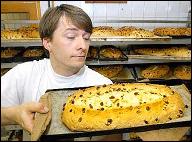
So important is the cake to the country, and in particular, the city of Dresden, that bakers must meet a stringent quality test in order to call their products genuine "Dresden Stollen." There is even an Association for the Protection of Dresden Stollen, which represents 150 producers, and sets the quality test for “superior” stollen. (so sniffing is apparently a criteria for judging stollen).
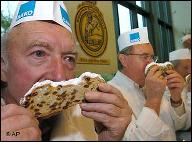
The first Stollen in the Middle Ages was a more austere affair -- a dry cake made of flour, yeast and water which nourished people through the fasting period leading up to Christmas. It was known as "Christbrod" ("Bread of Christ") and because of its shape, it represented the swaddled body of the infant Jesus.
In the 15th century, the Electoral Princes of Saxony found the cake too dry and in 1491, they were granted permission by Pope Innocent VIII to add butter to the recipe. Now that is a happening use for a papal decree.
The Stollen also became a form of currency in Communist times. Unlike the nationalized industries, bakers were not allowed to export their goods but customers would buy stollen by the dozen and send them to friends or relatives on the other side of the Iron Curtain in exchange for deutsche marks. When the Berlin Wall fell in 1989 and Germany was reunified a year later, sales of Stollen dropped because the people of Saxony no longer needed to exchange the cakes for western currency.
Now, I have tried the stollen, and like the fruit cake, it must be an acquired taste. Still, when in Germany, do as the Germans do….
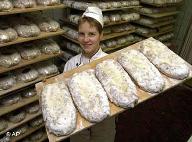
Wednesday, December 14, 2005
The evidence was on her nose
Paris Marathon Training: Week 2 of 18
Today’s target run: rest day
Now I know how our parents felt, when as children we did something we were not supposed to and tried to cover our tracks. I never could understand how my mom and dad were always able to “sniff” out the truth. I always seemed to conceive of a plausible story to masquerade as the truth but they quickly saw through it every time.
Well, I’ve had some insight into that situation with my feline child, Ginger. It’s all in the face, figuratively or literally. You see, our faces belied the smooth exterior of the dutiful child we were trying to project. Either we looked too angelic to be believable, or we'd left traces of the dirty deed on our person.
Let me give you an example. Every year, it is a challenge to decorate the Christmas tree in a way that will not tempt Ginger to bat around all the ornaments on the lower branches…or in her case, within the distance of a paw swipe. We’ve tried not hanging the ornaments on the lower branches, but the tree looks goofy. We moved on to the strategy of putting only non-breakable ornaments on the lower branches, which today is still the primary defense. We’ve even wrapped the ornament so tightly around the branches that we have trouble removing the ornament from the tree during Christmas tree disassembly.
The evidence of Christmas tree tampering is always quite apparent, though. Needles on the floor below the tree, presents that had been “stepped” on an attempt to get up under the tree to swipe at an ornament, ornaments all over the house, under sofas, and behind furniture. It had to be one of two felines, but still, we could never catch the exact culprit in the act.
Well, kitty CSI swept into action last week. As I lounged on the sofa watching TV, Ginger (a.k.a. Sweet Kitty) jumped into my lap, purring loudly and sticking her cold little nose in my face. “Give me some love because I am such a sweet and good kitty” she seemed to be saying.
And there it was…the evidence….right on the tip of her pink little nose and in the fur on her face….red glitter from the Christmas ornaments. And she did not even have a clue she had sold herself out…given herself up…game over.
I'm in the land of Nussknackers
· Beautifully crafted wooden figures that crack nuts in their jaws have existed since at least the 16th century, when artisans in Switzerland, France, Germany, England, and northern Italy carved them in a variety of animal and human forms. By the mid-1700s, they had become a common product of the Erzgebirge region of eastern Germany and Bohemia, an area famous for toy making, and were sold at the Dresden Christmas fair.
· The nutcracker made his first significant appearance in Nussknacker und Mausekönig (Nutcracker and Mouse King), a supernatural tale written by the German author and composer E.T.A. Hoffmann in 1816. The original story was a bit more sinister than Tchaikovsky’s Nutcracker Suite. Both stories, however, center around the nutcracker hero, a prince-like figure who fends off an invading army of mice on Christmas Eve.
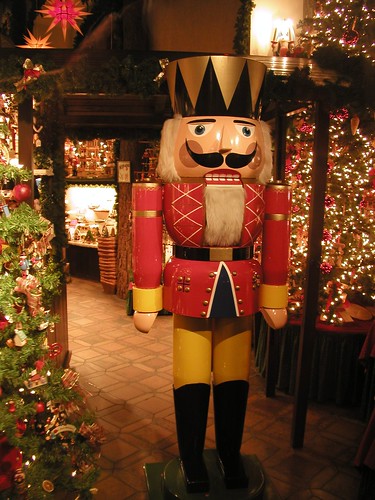
· At the time the story was originally penned, the nutcracker was a toy given to German children of well-to-do families. Wooden nutcrackers shaped like soldiers, kings, and other figures of authority were especially popular gifts at Christmas.
· In the first dictionary of High German, compiled by the Brothers Grimm in the 19th century, the nussknacker is defined as a tool “often in the form of a misshaped little man, in whose mouth the nut, by means of a lever or screw, is cracked open.”
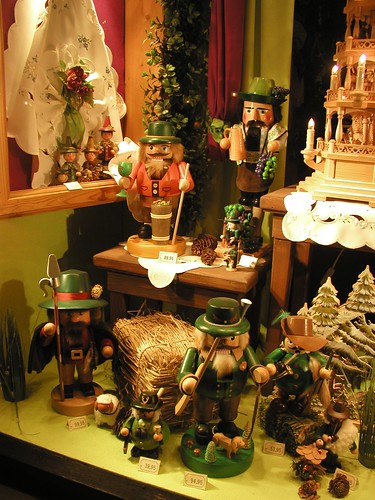
· The nutcracker did not always play the role of good-hearted prince or soldier. It was often given grotesque features and the long robe of a monk, a policeman’s uniform, or even the piked helmet and mustache of the Kaiser. By the end of the 19th century, most nutcrackers in toy catalogues were clearly caricatures of contemporary authorities. What started out as a practical tool became a medium for social commentary.
· The village of Seiffen (Saxony) remains the heart of nutcracker production today in Germany. More than 75% of all nutcrackers created in the region find their way to the American market.
Monday, December 12, 2005
THE Christmas decoration this year
Today’s target run: 33 minutes
Today’s completed run: 33 minutes
It’s funny how a holiday decoration catches on. Before you know it, everyone is putting these items in their yards, on their homes, and in their houses, etc. Whatever the new concept is for a given year, everyone seems to join right in.
Case in point: Remember when the “icicle lights” came out? Makes one wonder what we ever did before these were all the rage. Ever catch the fever of putting the Christmas light reindeer out in your yard? Alright, I could go on and on, but you get the picture.
Not that there is anything in the least wrong with jumping on the “Christmas decorating bandwagon”. I am simply curious how one concept seems to catch the imagination of the masses, and before you know it, that particular holiday decoration is everywhere you look.
In case you are wondering, I leave you with the visual of THE most popular Christmas decoration I have seen this year. Everyone in Germany has them….I even snapped a similar shot of this phenom in France last weekend.
Santa…scaling the walls, and appearing to be entering a home by crawling through an upper story window. No comin' down the chimney anymore.
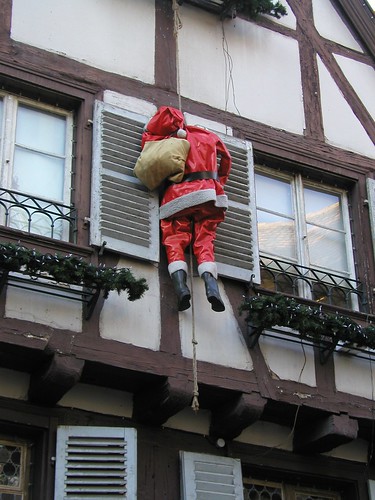
I hope Santa has been doing a little weight training in the off season, as he is going to need some major upper body work in order to crawl up into all those windows.
St. Lucia's Day
Lucia is said to have been beheaded by the sword during the persecutions of the Christians in Sicily. Her body was later brought to Constantinople and finally to Venice, where she rests now in the church of Santa Lucia. Because her name means "light", she very early on became the patron saint for the "light of the body"--the eyes. Many of the ancient light and fire customs of the Yuletide became associated with her. Today, "Lucy candles" are lit in the homes and "Lucy fires" burn outdoors during the advent season.
Traditionally, in the early hours of the morning of December 13th, a young woman, dressed in a white gown, and wearing a red sash and a crown of loganberry twigs and blazing candles, would go from one farm to another carrying a torch to light her way, stopping by each house with saffron buns and steaming coffee. She would return home by break of day. Every German village and each family had its own Lucia - usually the youngest daughter, who would wake the family in the morning with this tradition as well.
Today, many villages in Germany celebrate December 13th with a Festival of Lights….
A Case of Circular Logic
Today’s target run: 33 minutes
Today’s completed run: 33 minutes
Maybe it is my feeble brain, but I ended the telephone call more confused than before I spoke to the Lufthansa customer service rep. Essentially, I have been trying to navigate the airline's website (and in German) to get a frequent flyer number assigned to me. I figured...I am living in Germany, so I'll probably be flying on Luftansa a bit.
Great...found the website a few weeks ago, enrolled, and received the obligatory "Welcome to Luftansa's Mileage & More Program" email. Yet, no frequent flyer number was included. After scouring the website again today, I broke down and called the customer service hotline, surprising myself by obtaining an English speaking colleague.
Lufthansa: "Well, I see you were assigned a temporary program number. Here, let me give that to you....."
Hachie Gal: "Thank you very much Mr. Helpful Lufthansa Customer Service Rep. BTW, why did this number not appear in the email confirmation I received from Mileage & More?"
Lufthansa: "Well you are not a member of the Mileage & More program. This is your temporary number."
Hachie Gal: (hmmm...I thought that was what I registered for online...OK...don't panic...just probe a little more.) "What does the temporary number do?"
Lufthansa: "This is the number you will give to airline personnel when booking travel. You'll use this number till you collect 3000 air miles."
Hachie Gal: " Well, I never received the temporary number, so I have not been getting my miles credited. When will I receive my mileage card?"
Lufthansa: "Oh, you won't get a mileage card until you get an official Mileage & More account, which only happens after you fly 3000 miles. Then, you get an 'official' frequent flyer number and card mailed to you."
Hachie Gal: (hmmm again...a bit of consternation on my part.) "OK, so how can I check my mileage accrued so I'll know when I hit the 3000 air mile mark? Can I check that online?'
Lufthansa: "No, you can only set up an online account, which will allow you to check your account online, once you receive your permanent frequent flyer card. Remember, you can't get your frequent flyer card until you apply for membership in the official Mileage & More program, which can only occur after flying 3000 miles. So be sure to keep your temporary number handy."
Hachie Gal: (hmmm one more time... since I never got the temporary number in the first place so how could I ever use it?) " Er...thanks...will do!"
I am confused...need I say more?
Alsatian Christmas Markets
We technically violated our “weekend trips should never be more than a 3 hour drive by car” rule. How can you not do that when you are able to drive to France in a little over 4 hours? It really took us about 5 hours due to that pesky German Autobahn construction. Still, worth the drive…TOTALLY.
Our travels took us to several villages in the Alsace region of France, including Riquewihr, Ribeauville, Kayserberg, and Colmar. While our focus was primarily on all things “Christmas”, the Alsace wine route is also a lovely trip in the autumn time. And man, there was a castle on every hill. Yep, we’ll go back….
Nothing really new to tell you about these Christmas markets except that the town and home decorations were fabulous. Yes, I am already archiving ideas for the Hachie house upon my return. The usual suspects were there this time: mulled wine, food, ornaments, etc. The best food item eaten this weekend were these little Alsatian cookies. If I’d only broken into them earlier, I’d bought a few more while in Colmar.
For those who want to see all the photos from the weekend, check out Alsace Christmas Markets for the photo set for Alsace. Just be sure to click on the set entitled “Alsace Christmas Markets 2005” and then you can watch as a slideshow (I know, the title is so terribly clever).
Some of the photo highlights….
Riquewihr: